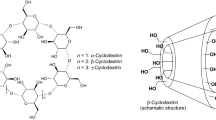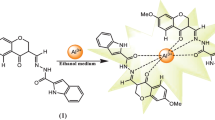Abstract
Copolymers consisting of N-3-acrylamidophenylboronic acid (APBA) and 2-hydroxyethyl methacrylate moieties (HEMA) were synthesized and their solubility and fluorescence properties were evaluated in the presence of sugar. The APBA–HEMA copolymer composed of 25 mol% of APBA moiety was found to be poorly soluble in water at pH 7.4. However, the water solubility of APBA–HEMA was improved in the presence of fructose in solution. The solubility of APBA–HEMA was influenced by fructose in a concentration-dependent manner, due to the formation of boronate ester of APBA moiety with fructose added. In addition, APBA–HEMA was modified with fluorescein isothiocyanate (FITC) for the fluorometric detection of sugars. The fluorescence intensity of FITC-modified APBA–HEMA was dependent on the type and concentration of sugars in solution. The fluorescence intensity of FITC-modified APBA–HEMA was highly enhanced by the addition of fructose, while the fluorescent response was negligibly small when other sugars were added. Thus, usefulness of FITC-modified APBA–HEMA for the selective determination of fructose was demonstrated.






Similar content being viewed by others
References
James TD, Sandanayake KRAS, Shinkai S (1996) Saccharide sensing with molecular receptors based on boronic acids. Angew Chem Int Ed Engl 35:1911–1922
Anzai J, Kobayashi Y (2000) Construction of multilayer thin films of enzymes by means of sugar-lectin interactions. Langmuir 16:2851–2856
Sato K, Imoto Y, Sugama J, Seki S, Inoue H, Odagiri T, Hoshi T, Anzai J (2005) Sugar-induced disintegration of layer-by-layer assemblies composed of concanavalin A and glycogen. Langmuir 21:797–799
Edwards JO, Morrison GC, Ross V, Schultz JW (1955) The structure of the aqueous borate ion. J Am Chem Soc 77:266–268
Lorand JP, Edwards JO (1959) Polyol complexes and structure of the benzeneboronate ion. J Org Chem 24:769–774
Jin X, Zhang X, Wu Z, Teng D, Zhang X, Wang Y, Wang Z, Li C (2009) Amphiphilic random glycopolymer based on phenylboronic acid: synthesis, characterization, and potential as glucose-sensitive matrix. Biomacromolecules 10:1337–1345
Lapeyre V, Ancla C, Catargi B, Ravaine V (2008) Glucose-responsive microgels with a core–shell structure. J Colloid Interface Sci 327:316–323
Greest BGD, Jonas AM, Demeester J, Smedt SCD (2006) Glucose-responsive polyelectrolyte capsules. Langmuir 22:5070–5074
Friggeri A, Kobayashi H, Shinkai S, Reinhoudt DN (2001) From solutions to surfaces: a novel molecular imprinting method based on the conformational changes of boronic-acid-appended poly(L-lysine). Angew Chem Int Ed 40:4729–4731
Li S, Davis EN, Anderson J, Lin Q, Wang Q (2009) Development of boronic acid grafted random copolymer sensing fluid for continuous glucose monitoring. Biomacromolecules 10:113–118
Springsteen G, Wang B (2002) A detailed examination of boronic acid–diol complexation. Tetrahedron 58:5291–5300
Camara JN, Suri JT, Cappuccio FE, Wessling RA, Singaram B (2002) Boronic acid substituted viologen based optical sugar sensors: modulated quenching with viologen as a method for monosaccharide detection. Tetrahedron Lett 43:1139–1141
Egawa Y, Gotoh R, Niina S, Anzai J (2007) Ortho-azo substituted phenylboronic acids for colorimetric sugar sensors. Bioorg Med Chem Lett 17:3789–3792
Yoon J, Czarnik AW (1992) Fluorescent chemosensors of carbohydrates. A means of chemically communicating the binding of polyols in water based on chelation-enhanced quenching. J Am Chem Soc 114:5874–5875
DiCesare N, Lakowicz JR (2002) Chalcone-analogue fluorescent probes for saccharides signaling using the boronic acid group. Tetrahedron Lett 43:2615–2618
Kikuchi A, Suzuki K, Okabayashi O, Hoshino H, Kataoka K, Sakurai Y, Okano T (1996) Glucose-sensing electrode coated with polymer complex gel containing phenylboronic acid. Anal Chem 68:823–828
Takahashi S, Anzai J (2005) Phenylboronic acid monolayer-modified electrodes sensitive to sugars. Langmuir 21:5102–5107
Sato K, Anzai J (2006) Fluorometric determination of sugars using fluorescein-labeled concanavalin A–glycogen conjugates. Anal Bioanal Chem 384:1297–1301
Kada G, Falk H, Gruber HJ (1999) Accurate measurement of avidin and streptavidin in crude biofluids with a new, optimized biotin–fluorescein conjugate. Biochim Biophys Acta 1427:33–43
Wu J-H, Diamond SL (1995) A fluorescence quench and dequench assay of fibrinogen polymerization, fibrinogenolysis, or fibrinolysis. Anal Biochem 224:83–91
Chen RF, Knutson JR (1988) Mechanism of fluorescence concentration quenching of carboxyfluorescein in liposomes: energy transfer to nonfluorescent dimers. Anal Biochem 172:61–77
Acknowledgment
This study was supported, in part, by a Grant-in-Aid for Young Scientists (B) (21790031) from Japan Society for Promotion of Sciences (JSPS).
Author information
Authors and Affiliations
Corresponding author
Rights and permissions
About this article
Cite this article
Sato, K., Nakajima, T., Yasukawa, Y. et al. Sugar-dependent solubility and fluorescence property of copolymers consisting of phenylboronic acid and 2-hydroxyethyl methacrylate moieties. Polym. Bull. 65, 807–814 (2010). https://doi.org/10.1007/s00289-010-0278-x
Received:
Revised:
Accepted:
Published:
Issue Date:
DOI: https://doi.org/10.1007/s00289-010-0278-x




